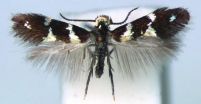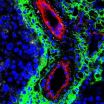(Press-News.org) When Sifrhippus, the earliest known horse, first appeared in the forests of North America more than 50 million years ago, it would not have been mistaken for a Clydesdale. It weighed in at around 12 pounds -- and it was destined to get much smaller over the ensuing millennia.
Sifrhippus lived during the Paleocene-Eocene Thermal Maximum, a 175,000-year interval of time some 56 million years ago in which average global temperatures rose by about 10 degrees Fahrenheit, caused by the release of vast amounts of carbon into the atmosphere and oceans.
About a third of mammal species responded with significant reduction in size during the PETM, some by as much as one-half. Sifrhippus shrank by about 30 percent to the size of a small house cat (about 8.5 pounds) in the PETM's first 130,000 years and then rebounded to about 15 pounds in the final 45,000 years of the PETM.
Scientists have assumed that rising temperatures or high concentrations of carbon dioxide primarily caused the phenomenon in mammals during this period, and new research led by Ross Secord of the University of Nebraska-Lincoln and Jonathan Bloch of the Florida Museum of Natural History at the University of Florida in Gainesville offers new evidence of the cause-and-effect relationship between temperature and body size. Their findings also offer clues to what might happen to animals in the near future from global warming.
In a paper to be published in the Feb. 24 issue of the international journal Science, Secord, Bloch and colleagues used measurements and geochemical composition of fossil mammal teeth to document a progressive decrease in Sifrhippus' body size that correlates very closely to temperature change over a 130,000-year span.
Bloch, associate curator of vertebrate paleontology at the Florida Museum of Natural History, said multiple trails led to the discovery.
One was the fossils themselves, recovered from the Cabin Fork area of the southern Bighorn Basin near Worland, Wyo. Stephen Chester, then an undergraduate student at Florida, now an anthropology Ph.D. candidate at Yale and a co-author on the paper, had the task of measuring the horses' teeth. What he found when he plotted them through time caught Bloch and Secord by surprise.
"He pointed out that the first horses in the section were much larger than those later on," Bloch recalled. "I thought something had to be wrong, but he was right -- and the pattern became more robust as we collected more fossils."
A postdoctoral researcher in Bloch's lab for the first year of the project, Secord performed the geochemical analysis of the oxygen isotopes in the teeth. What he found provided an even bigger surprise.
"It was absolutely startling when Ross pulled up the first oxygen isotope data," Bloch said. "We looked at the curve and we realized that it was exactly the same pattern that we were seeing with the horse body size.
"For the first time, going back into deep time -- going back tens of millions of years -- we were able to show that indeed temperature was causing essentially a one-to-one shift in body size within this lineage of horse. Because it's over a long enough time, you can argue very strongly that what you're looking at is natural selection and evolution -- that it's actually corresponding to the shift in temperature and driving the evolution of these horses."
Secord, who came to UNL in 2008 as an assistant professor of Earth and atmospheric sciences and curator of vertebrate paleontology at the University of Nebraska State Museum, said the finding raises important questions about how plants and animals will respond to rapid change in the not-too-distant future.
"This has implications, potentially, for what we might expect to see over the next century or two, at least with some of the climate models that are predicting that we will see warming of as much as 4 degrees Centigrade (7 degrees Fahrenheit) over the next 100 years," he said.
Those predictions are based largely on the 40 percent increase of atmospheric carbon dioxide levels (from 280 to 392 parts per million) since the start of the Industrial Revolution in the mid-19th century.
Ornithologists, Secord said, have already started to notice that there may be a decrease in body size among birds.
"One of the issues here is that warming (during the PETM) happened much slower, over 10,000 to 20,000 years to get 10 degrees hotter, whereas now we're expecting it to happen over a century or two," Secord said. "So there's a big difference in scale and one of the questions is, 'Are we going to see the same kind of response?' Are animals going to be able to keep up and readjust their body sizes over the next couple of centuries?"
Increased temperatures are not the only change animals will have to adapt to, Secord said. Greenhouse experiments show that increased atmospheric carbon dioxide lowers the nutritional content of plants, which he said could have been a secondary driver of dwarfism during the PETM.
INFORMATION:
Other co-authors on the paper are Doug M. Boyer of Brooklyn College, Aaron R. Wood of the Florida Museum of Natural History, Scott L. Wing of the Smithsonian National Museum of Natural History, Mary J. Kraus of the University of Colorado-Boulder, Francesca A. McInerny of Northwestern University, and John Krigbaum of the University of Florida.
The research was funded by grants from the National Science Foundation, with additional support from UNL.
Study: Evolution of earliest horses driven by climate change
New research offers evidence of rising temperatures' effects on body size
2012-02-24
ELSE PRESS RELEASES FROM THIS DATE:
Genetic risk for elevated arsenic toxicity discovered
2012-02-24
One of the first large-scale genomic studies conducted in a developing country has discovered genetic variants that elevate the risk for skin lesions in people chronically exposed to arsenic. Genetic changes found near the enzyme for metabolizing the chemical into a less toxic form can significantly increase an individual's risk for developing arsenic-related disease.
The discovery could point the way to new screening and intervention options for people who are exposed to groundwater with high levels of arsenic, said scientists at the University of Chicago Medicine, Columbia ...
Italian vineyards invaded from North America by new species of leafminer
2012-02-24
Since in 2006 an unknown leafmining moth was found in North Italian vineyards by Mario Baldessari and colleagues, often in great numbers, scientists have tried to put a name to this apparently new invader. Italian scientists from the Fondazione Edmund Mach di San Michele all'Adige and the Università di Padova turned for help to taxonomists in the Netherlands and United States. The new species was described in the open access journal ZooKeys.
The family to which the moth belongs, the shield bearing leafminers (Heliozelidae) appeared to be poorly studied in North America, ...
Global Gaming Events Launches $5,000 Slots Freeroll with Casino Titan Open to All Depositing Players Including USA
2012-02-24
Global Gaming Events launches another whopping $5,000 casino freeroll tournament with Casino Titan to be held in March 2012.
This event runs on Saturday, March 3rd, 2012 3pm ET to Sunday, March 4th, 2012 3pm ET. All players who have made at least one deposit or reload of a minimum of $50 during the month of February 2012 are eligible to play. Players must also pre-register for the event with Global Gaming Events to be eligible.
The tournament formats will be a 10 minute 5,000 Starting Chip Slot Tournaments and will have a maximum of 1000 players. Each player will ...
Breaking down cancer's defense for future vaccines
2012-02-24
Researchers at the EPFL have identified an important mechanism that could lead to the design of more effective cancer vaccines. Their discovery of a new-found role of the lymphatic system in tumour growth shows how tumours evade detection by using a patient's own immune system.
Tumour cells present antigens or protein markers on their surfaces which make them identifiable to the host immune system. In the last decade, cancer vaccines have been designed that work by exposing the patient's immune cells to tumour-associated antigens and so priming them to kill cells that ...
Sani Beach Club Services Upgraded and Improved for 2012
2012-02-24
Sani Beach Club is situated on its own stretch of private beach within Sani Resort on the beautiful Kassandra peninsula in Halkidiki, Northern Greece.
New Dining Options
There are three exceptional restaurants at Sani Beach Club - Dunes, Olympos and Ouzerie, each has redesigned its menu to offer guests a more traditional Greek gourmet experience. The new menu at Ouzerie has an innovative new twist that is similar to Sani Resort's famous new-age Greek restaurant Tomata. There will be a new Greek themed breakfast menu offering guests traditional morning specialities ...
Farm 'weeds' have crucial role in sustainable agriculture
2012-02-24
Plants often regarded as common weeds such as thistles, buttercups and clover could be critical in safe guarding fragile food webs on UK farms according to Researchers funded by the Biotechnology and Biological Sciences Research Council (BBSRC).
Published tomorrow in Science, researchers from the University of Bristol detail the interactions that occur between the different food webs commonly found on farms throughout the UK and the robustness of these interactions to species loss. In one of the first studies to look simultaneously at multiple types of food webs, the researchers ...
Earliest horses show past global warming affected body size of mammals
2012-02-24
GAINESVILLE, Fla. --- As scientists continue developing climate change projection models, paleontologists studying an extreme short-term global warming event have discovered direct evidence about how mammals respond to rising temperatures.
In a study appearing in Science Feb. 24, researchers from eight institutions led by scientists from the University of Florida and University of Nebraska found a correlation between temperature and body size in mammals by following the evolution of the earliest horses about 56 million years ago: As temperatures increased, their body ...
Study examines number of GP visits before cancer patients are referred to specialists
2012-02-24
More than three quarters (77%) of cancer patients who first present to their family doctors (GPs) with suspicious symptoms are referred to hospital after only one or two consultations, a new study has found. However, the new research also shows a wide variation in the number of times a cancer patient sees their general practitioner before they are referred to a specialist, with the most pre-referral consultations occurring when the cancer was one of the less common types, or when the patient was either female, young, or an older person from an ethnic minority. The research ...
Eating citrus fruit may lower women's stroke risk
2012-02-24
A compound in citrus fruits may reduce your stroke risk, according to research reported in Stroke: Journal of the American Heart Association.
This prospective study is one of the first in which researchers examine how consuming flavonoid subclasses affects the risk of stroke. Flavonoids are a class of compounds present in fruits, vegetables, dark chocolate and red wine.
"Studies have shown higher fruit, vegetable and specifically vitamin C intake is associated with reduced stroke risk," said Aedín Cassidy, Ph.D., the study's lead author and professor of nutrition at ...
Memory formation triggered by stem cell development
2012-02-24
Researchers at the RIKEN-MIT Center for Neural Circuit Genetics have discovered an answer to the long-standing mystery of how brain cells can both remember new memories while also maintaining older ones.
They found that specific neurons in a brain region called the dentate gyrus serve distinct roles in memory formation depending on whether the neural stem cells that produced them were of old versus young age.
The study will appear in the March 30 issue of Cell and links the cellular basis of memory formation to the birth of new neurons -- a finding that could unlock ...
LAST 30 PRESS RELEASES:
Heart-brain connection: international study reveals the role of the vagus nerve in keeping the heart young
Researchers identify Rb1 as a predictive biomarker for a new therapeutic strategy in some breast cancers
Survey reveals ethical gaps slowing AI adoption in pediatric surgery
Stimulant ADHD medications work differently than thought
AI overestimates how smart people are, according to HSE economists
HSE researchers create genome-wide map of quadruplexes
Scientists boost cell "powerhouses" to burn more calories
Automatic label checking: The missing step in making reliable medical AI
Low daily alcohol intake linked to 50% heightened mouth cancer risk in India
American Meteorological Society announces Rick Spinrad as 2026 President-Elect
Biomass-based carbon capture spotlighted in newly released global climate webinar recording
Illuminating invisible nano pollutants: advanced bioimaging tracks the full journey of emerging nanoscale contaminants in living systems
How does age affect recovery from spinal cord injury?
Novel AI tool offers prognosis for patients with head and neck cancer
Fathers’ microplastic exposure tied to their children’s metabolic problems
Research validates laboratory model for studying high-grade serous ovarian cancer
SIR 2026 delivers transformative breakthroughs in minimally invasive medicine to improve patient care
Stem Cell Reports most downloaded papers of 2025 highlight the breadth and impact of stem cell research
Oxford-led study estimates NHS spends around 3% of its primary and secondary care budget on the health impacts of heat and cold in England
A researcher’s long quest leads to a smart composite breakthrough
Urban wild bees act as “microbial sensors” of city health.
New study finds where you live affects recovery after a hip fracture
Forecasting the impact of fully automated vehicle adoption on US road traffic injuries
Alcohol-related hospitalizations from 2016 to 2022
Semaglutide and hospitalizations in patients with obesity and established cardiovascular disease
Researchers ‘listen in’ to embryo-mother interactions during implantation using a culture system replicating the womb lining
How changing your diet could help save the world
How to make AI truly scalable and reliable for real-time traffic assignment?
Beyond fragmented markets: A new framework for efficient and stable ride-pooling
Can shape priors make road perception more reliable for autonomous driving?
[Press-News.org] Study: Evolution of earliest horses driven by climate changeNew research offers evidence of rising temperatures' effects on body size



